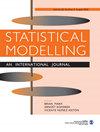一个贝叶斯框架建模的优先选择过程在受访者驱动的抽样
IF 1.2
4区 数学
Q2 STATISTICS & PROBABILITY
引用次数: 1
摘要
在利用同伴招募的抽样设计中,抽样过程部分未知,必须建模以推断人群并估计流行率等标准结果。我们为受访者驱动抽样(RDS)的招募过程开发了一个贝叶斯模型,这是一种在全球范围内使用的网络抽样方法,用于对传统抽样技术无法到达的隐藏人群进行抽样,包括艾滋病毒/艾滋病高危人群。RDS抽样过程的当前模型通常假设招聘是在给定人群社交网络的情况下随机发生的,但这在实践中可能是不真实的。为了对协变量上的优先选择进行建模,我们开发了一个顺序双侧理性选择框架,该框架允许为RDS采样过程创建生成概率网络模型。在理性选择框架中,群体成员基于可观察的节点和二元协变量做出招募和参与选择,以在给定约束的情况下最大化其效用。在贝叶斯框架中,通过结合潜在效用和通过马尔可夫链蒙特卡罗从联合后验分布中采样,对给定观察到的招募链的招募偏好进行推断。我们给出了模拟结果,并将该模型应用于摩洛哥拉巴特法语移民的RDS研究。本文章由计算机程序翻译,如有差异,请以英文原文为准。
A Bayesian framework for modelling the preferential selection process in respondent-driven sampling
In sampling designs that utilize peer recruitment, the sampling process is partially unknown and must be modelled to make inference about the population and estimate standard outcomes like prevalence. We develop a Bayesian model for the recruitment process for respondent-driven sampling (RDS), a network sampling methodology used worldwide to sample hidden populations that are not reachable by conventional sampling techniques, including those at high risk for HIV/AIDS. Current models for the RDS sampling process typically assume that recruitment occurs randomly given the population social network, but this is likely untrue in practice. To model preferential selection on covariates, we develop a sequential two-sided rational choice framework, which allows generative probabilistic network models to be created for the RDS sampling process. In the rational choice framework, members of the population make recruitment and participation choices based on observable nodal and dyadic covariates to maximize their utility given constraints. Inference is made about recruitment preferences given the observed recruitment chain in a Bayesian framework by incorporating the latent utilities and sampling from the joint posterior distribution via Markov chain Monte Carlo. We present simulation results and apply the model to an RDS study of Francophone migrants in Rabat, Morocco.
求助全文
通过发布文献求助,成功后即可免费获取论文全文。
去求助
来源期刊

Statistical Modelling
数学-统计学与概率论
CiteScore
2.20
自引率
0.00%
发文量
16
审稿时长
>12 weeks
期刊介绍:
The primary aim of the journal is to publish original and high-quality articles that recognize statistical modelling as the general framework for the application of statistical ideas. Submissions must reflect important developments, extensions, and applications in statistical modelling. The journal also encourages submissions that describe scientifically interesting, complex or novel statistical modelling aspects from a wide diversity of disciplines, and submissions that embrace the diversity of applied statistical modelling.
 求助内容:
求助内容: 应助结果提醒方式:
应助结果提醒方式:


